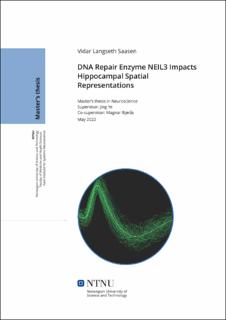| dc.contributor.advisor | Ye, Jing | |
| dc.contributor.advisor | Bjørås, Magnar | |
| dc.contributor.author | Saasen, Vidar Langseth | |
| dc.date.accessioned | 2022-08-02T17:19:57Z | |
| dc.date.available | 2022-08-02T17:19:57Z | |
| dc.date.issued | 2022 | |
| dc.identifier | no.ntnu:inspera:110931002:64327785 | |
| dc.identifier.uri | https://hdl.handle.net/11250/3009852 | |
| dc.description.abstract | Endonuclease VIII-like 3 (NEIL3) DNA glycosylase er et enzym som spiller en rolle i initieringen av en viktig DNA reparasjonsprosess. I den siste tiden har det kommet frem nye funn som fremhever rollene NEIL3 spiller utenom DNA reparasjon, og blant disse rollene er en interaksjon med hukommelsessystemet i hjernen. Hovedmålet med denne studien var å finne ut om NEIL3 påvirker den funksjonelle plastisiteten av plass celler i CA1 og DG i hippocampus. For å adressere hovedmålet, implanterte jeg fire mikrodrivere med fire intrakranielle tetroder (16 elektroder) i hippocampus på mus, og målte nevral aktivitet i CA1 og DG. Jeg målte fire mus (to villtyper og to som manglet genet for NEIL3). Celler fra en villtype og en som manglet genet for NEIL3 ble gruppert og analysert. Basert på analyser av disse cellene fant jeg at musa som manglet NEIL3 hadde færre celler som hadde flere en ett plassfelt, større plassfelt, og høyere nevral aktivitet innad i plassfeltene. Dette er en indikasjon på at spesifisiteten til plass cellene er påvirket av NEIL3. Videre fant jeg tegn på svekkelse i evnen til å danne nye mentale representasjoner av rommet i plass cellene i DG når mus som manglet NEIL3 ble introdusert til et nytt område. Jeg fant også at stabiliteten til plass cellene i DG ikke viste tegn til forstyrrelser, i motsetning av tidligere funn fra CA1. Disse resultatene indikerer at den funksjonelle plastisiteten til plass celler i DG kan være forskjellige fra den funksjonelle plastisiteten i CA1. Flere celler og dyr er nødvendig for å kunne gjøre solide konklusjoner.
Det sekundære målet med denne studien var å belyse om NEIL3 påvirker angst og romlig hukommelse. For å adressere det sekundære målet brukte jeg tre forskjellige adferseksperimenter: open field, ny objektlokasjon, og y-labyrinten. Totalt ble 30 mus (ni unge og seks gamle villtyper, og ni unge og seks gamle mus uten Neil3 genet) testet i disse eksperimentene. Unge mus som manglet NEIL3 hadde tendenser til angst i open field eksperimentet, i motsetning til tidligere funn fra eldre mus som manglet NEIL3. Når musene ble testet med en hukommelsestest fant jeg indikasjon på hukommelsessvikt når musene ble testet i en langtidsbetingelse, men ikke i en korttidsbetingelse. Jeg konkluderer at funnene indikerer at NEIL3 spiller en rolle i funksjonell plastisitet i hippocampus, angst, og i romlig hukommelse. | |
| dc.description.abstract | The endonuclease VIII-like 3 (NEIL3) DNA glycosylase is an enzyme that has a role in initiating DNA base excision repair pathways. Recently, there has been emerging evidence highlighting the non-canonical roles of NEIL3 in the brain, associating it with hippocampal function and memory. The main aim of this study was to elucidate whether NEIL3 impacts the functional plasticity of hippocampal neurons using electrophysiology strategies. To address the main aim, I (i) assembled microdrives with four intracranial tetrodes (16 electrodes) that were implanted in the mouse hippocampus and (ii) recorded place cells in the hippocampal CA1 and DG regions in behaving mice. I successfully recorded the activity of hippocampal place cells in four animals (two wildtype and two NEIL3-deficient). Cells from one wildtype and one NEIL3-deficient mice were clustered and analysed. Based on the analysis of two animals, I found that the NEIL3 deficient mouse exhibited fewer cells in the hippocampal CA1 with multiple place fields, bigger field size, and higher field peak firing rate compared to cells from the wildtype mouse, suggesting a disruption in the spatial specificity. Further, place cells recorded in the DG of the NEIL3-deficient mouse displayed signs of impaired remapping, as the mouse showed decreased ability to generate new functional representations when moved from a familiar environment to a novel one. However, NEIL3-deficient place cells in DG did not show impaired spatial stability. This contrasts with an earlier study that found impaired stability in CA1 place cells. These results suggest that the functional plasticity of DG place cells may deviate from the functional plasticity in CA1 of NEIL3-deficient mice. More cells and animals need to be included in the study to make a solid conclusion.
The secondary aim of this study was to elucidate whether NEIL3 impacts anxiety and spatial memory. To address the secondary aim, I used three different behavioural experiments: the open field, the novel object location, and the y-maze. A total of 30 mice (nine young and six old wildtype mice, and nine young and six old NEIL3 deficient mice) were tested in these experiments. The young NEIL3 deficient mice had tendencies towards anxious behaviour in an open field experiment, contrary to what has been previously described. Further, the young NEIL3 deficient mice also travelled a shorter distance at a lower speed, indicating reduced general locomotor activity. In the novel object location task, I tested both short-term and long-term spatial memory. The NEIL3 deficient mice showed indications of impaired memory in the long-term condition, but not in the short-term condition. In conclusion, the findings indicates that depletion of NEIL3 leads to increased anxiety-like behaviour and impaired long-term spatial memory. | |
| dc.language | eng | |
| dc.publisher | NTNU | |
| dc.title | DNA Repair Enzyme NEIL3 Impacts Hippocampal Spatial Representations | |
| dc.type | Master thesis | |
